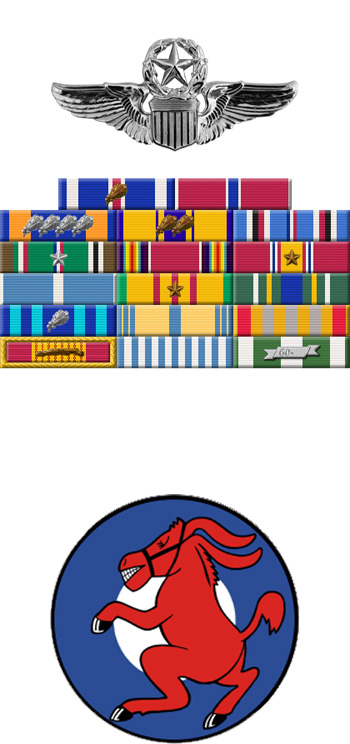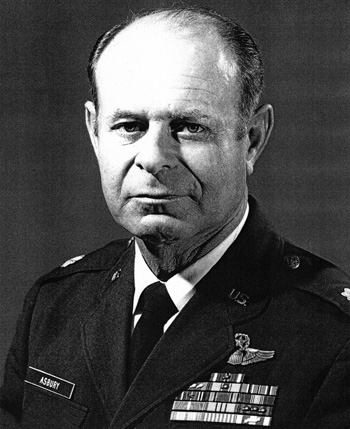
|
Richard W. Asbury |
 |
|||
| Rank, Service | ||||
Lieutenant Colonel O-5, U.S. Air Force |
||||
| Veteran of: | ||||
|
||||
| Tribute: | ||||
Richard Asbury was born on September 24, 1920, in Prince Frederick, Maryland. He enlisted in the U.S. Army Reserve on April 28, 1942, and entered the Aviation Cadet Program of the U.S. Army Air Forces on August 29, 1942. Asbury was commissioned a 2d Lt and awarded his pilot wings at Marianna Field, Florida, on May 28, 1943, and then completed fighter training before serving with the 382nd Fighter Squadron of the 363rd Fighter Group from August 1943 to September 1944. During this time, Lt Asbury deployed with his squadron to England in December 1943, and was credited with the destruction of 1.5 enemy aircraft in aerial combat plus 3 damaged before returning to the U.S. in August 1944. Capt Asbury returned to combat with the 356th Fighter Squadron of the 354th Fighter Group in England in November 1944, and he destroyed another 3.5 enemy aircraft in the air, making him an ace with 5 destroyed and 3 damaged. He returned to the U.S. in April 1945, and left active duty and joined the Air Force Reserve on August 10, 1945. He was recalled to active duty on July 25, 1950, and then served as an instructor pilot with the 3575th Pilot Training Wing at Vance AFB, Oklahoma, from July 1950 to May 1954, followed by service as an advisor to the South Korean Air Force until April 1955. His next assignment was as an instructor with the ROTC detachment at the University of Illinois from May 1955 to September 1956, and then at Purdue University from September 1956 to September 1958. Maj Asbury next completed B-52 Stratofortress Combat Crew Training and then served with the 718th Bomb Squadron at Ellsworth AFB, South Dakota, until February 1959, when he transferred to the 77th Bomb Squadron, also at Ellsworth AFB. He transferred to the 717th Bomb Squadron at Ellsworth in November 1959, and then served with the 4245th Strategic Wing at Sheppard AFB, Texas, from August 1960 to December 1963. His next assignment was on the staff with Headquarters U.S. Air Forces Southern Command at Albrook AFB, Panama Canal Zone, from December 1963 to July 1964, followed by a tour with Headquarters U.S. Air Force in the Pentagon until July 1968. Col Asbury then deployed to Clark AB in the Philippines, where he served first on the staff of 13th Air Force, and then on the staff of the 6th Air Division, and finally as Base Operations Staff Officer from July 1968 to September 1970. He deployed to South Vietnam in September 1970, and served as an O-2 Milirole Forward Air Control Pilot with the 21st Tactical Air Support Squadron at Cam Ranh Bay AB until March 1971, when he became base commander of Pleiku AB, South Vietnam. Col Asbury returned to the U.S. in October 1971, and then served on the staff of the 24th Air Division at Malmstrom AFB, Montana, until his retirement from the Air Force on May 1, 1972. |
||||
|
||||

